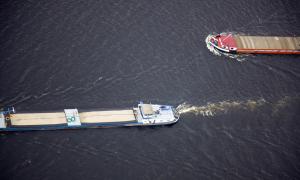The CLINSH project is coming to an end. In ths articel you'll read the last state of affairs of the CLINSH project. The results of the project will be disseminated at the end conference at 25 November 2021 in Rotterdam (NL). Please check our website on a regular basis for more information about the final conference
Analysis monitoring data
After the Nox emission data has been continuously collected on 43 ships over a longer period, together with other relevant data such as oxygen, pressure, fuel consumption, sailing speed and position, so-called emission factors have been derived for the various techniques and fuels. These factors describe the relationship between the engine power and the NOx emissions per ship and are aggregated per technology or fuel. Reference measurements were carried out for particulate matter (PM) based on the E3 measurement cycle. Because this resulted in a more limited number of measurement data, these measurements were mainly used to determine the degree of emission reduction and the emission factors were also determined with the help of other studies and literature. Fleet scenarios have been drawn up based on the emission factors and data from the inland shipping fleet in general and the shipping movements (including based on AIS registrations). The expected emissions and emission reductions for the coming years have been modeled using these scenarios and the derived emission factors. Based on this, the expected air quality is calculated and mapped for several relevant areas, such as the ports of Rotterdam and Duisburg.
Shore power
Several shore power installations have been realized within CLINSH. Based on experiences with these installations and information from other studies, the (potential) effect of shore power installations on air quality in port areas has been calculated. In addition, so-called energy scans are carried out in the ports of Antwerp and Ghent, whereby an inventory is done in cooperation with participating inland vessels of the technical adjustments that might be needed on the ships to use the shore power installations. An inventory is also made of other obstacles skippers see themselves for this. The aim is to encourage the use of shore power.
Final report with recommendations
During the summer months the draft final report will be finalized. In this report all results will be described and the policy and other recommendations will be formulated. This report will be discussed in a CLINSH consortium meeting that will (when possible) take place in Ghent in mid-September.
Final conference CLINSH
The final conference of CLINSH is scheduled for November 25, 2021 in Rotterdam. We aim to organize this as a physical meeting as much as possible, with the option to follow it online as well. More information about this conference will follow.

